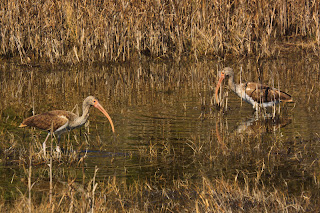
The first Whoopers we saw were a pair known as the Lobsticks. They are named for Lobstick Creek in northern Canda where they spend summers and hatch their young. This pair is unique in that the male was fledged in 1978 and is now almost 33 years old, quite venerable for a Whooping Crane. Whoopers mate for life, and normally live 15-20 years in the wild. He looks pretty good for an old man, doesn't he!
Although the Lobstick male is not banded, observers can identify him because the cranes are very territorial and return to the same locations each spring and fall. They defend their homes and drive off any other cranes that try to move in. This year, only the Lobstick male and female returned to Aransas. They did not bring a young crane with them. Either they did not have a successful nesting season, or the youngster died or was taken by a predator.
Male and female Whooping Cranes look alike, except that the male is larger. They stand almost 5 feet tall, and have a wingspan of 7 feet. In flight, their black wingtips are quite striking, and you can recognize them by their necks extended straight forward and their legs trailing behind well past their tails. These cranes are searching for blue crabs in the marshes alongside the bay. The second bird has a small friend which I think may be a Lesser Yellowlegs. However, I'm a photographer, not an experienced birder, so I'll cheerfully accept a correction if someone has better information.
Juvenile Whooping Cranes have a mixture of brown and white body feathers with black wingtips. We observed this juvenile and his or her parents searching for blue crabs in the marshes beside the bay. Not all juveniles can be identified, but this one carries bright bands on one leg and an antenna and radio transmitter on the other. He should be easy to identify as he moves back and forth between Aransas and Canada.
The parents stay close to the youngster until they return to their nesting grounds in Canada. Then they will drive him away and raise a new family. The young cranes band together in groups called cohorts until they reach maturity at about 3 years. Then they choose mates, find territories and begin the cycle all over again.
As we returned from our trip to see the cranes, Captain Tommy brought the Skimmer carefully alongside a Great Blue Heron rookery. Great Blue Herons are among the first of the resident shore birds to breed and nest, sometimes as early as December or January. The rookery was crowded with herons. In breeding plumage, they are quite spectacular with long, trailing feathers and bright faces.

We saw a number of smaller shore birds on our trip, including this rare Long-Tailed Duck that was just bobbing along by itself in the bay. I'll admit, it just looks like a duck to me, but all the birders on the boat were very excited to see it.
It was a great trip, and one we highly recommend if you're in the area.

















